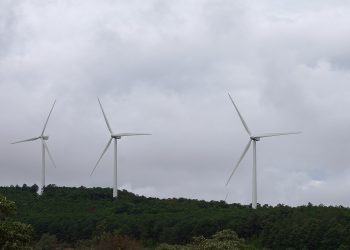Nuclear power is dirty and dangerous now, and for many generations to come. The following ten reasons state why nuclear has no future.
- Nuclear power is too slow to help mitigate the climate crisis. A 2022 report by the National Academies of Science found that most advanced reactors, including small modular nuclear reactors (SMNRs), “will confront significant challenges in meeting commercial deployment by 2050.” In contrast, the Burchill Wind Farm near Saint John took three and a half years from partnership to full deployment. Canada’s target to reduce carbon emissions by 40 to 45 per cent below 2005 levels by 2030 is looming. Renewables with storage, energy efficiency and conservation, demand-side management, and interties such as the Atlantic Loop can provide reliable baseload electricity. To wait for the SMNR silver bullet, which may never come, is to court climate catastrophe.
- Nuclear power is too expensive compared to alternatives. Wind and solar both undercut nuclear power rates. The authoritative Lazard energy analysis for 2023 costed storage-backed onshore wind and solar at US $42 to $114 per megawatt-hour, compared to nuclear power at US $141 to $221. Power from SMNRs will probably be more expensive than electricity from large nuclear plants with their history of cost increases. Crucially, SMNRs can’t take advantage of the economies of scale which large reactors do. There are orders for only single SMNRs, making it unlikely that multiple units will ever be built.
- Chronic exposure to radioactive pollutants emitted from nuclear power plants can damage human health. The thyroid absorbs radioactive iodine as readily as non-radioactive iodine, putting children at particular risk of thyroid disease and cancer. Chronic exposure to radioactive materials, even at low doses, increases the incidence of cancer, leukemia, anemia, genetic damage, immune system damage, strokes, heart attacks, and low intelligence.
- Liquid sodium and molten salt reactors pre-dating the ARC and Moltex SMR designs were unreliable and dangerous. Internationally, sodium reactors have not performed reliably; one in Russia experienced repeated fires. In the 1960s, the US Molten Salt Reactor Experiment (1965-1969) operated at only 40 per cent capacity compared to 90 per cent for the average US commercial nuclear power plant.
- Nuclear power does not work effectively with renewable energy. A University of Sussex study of 123 countries over 25 years found that countries that invested in renewable energy reduced more carbon emissions than countries with large percentages of nuclear power. Contrary to the claim that nuclear energy and renewables work well together, the study found that they “crowd each other out.”
- Radioactive waste remains an unsolved conundrum and will be an ongoing cost to taxpayers far into the future. Deep geological repositories (DGRs) for the disposal of high-level nuclear waste fuel are not operational anywhere in the world, including Finland and Sweden. The two locations Ignace and Saugeen Ojibway Nation under consideration in Ontario are opposed by many, including Indigenous peoples. A little-known fact is that while the waste fuel is the responsibility of the federal government, the provinces are responsible for the steel and concrete building materials which will ultimately become radioactive rubble. Would Canadians accept having a nuclear waste dump in or near their community?
- Many Indigenous leaders and First Nations are skeptical of nuclear reactors, nuclear waste, environmental risks, and groundwater contamination posed by the long-term storage of such wastes. First Nations in Ontario and Quebec do not want radioactive waste from New Brunswick in their territories. Federal and provincial governments have a history of not consulting First Nations and ignoring their concerns about nuclear installations. The Peskotomukhati Nation at Skutik and the Wolastoq Grand Council are firmly opposed to nuclear development. Nuclear does not align with their sacred principle of caring for the next seven generations.
- Transporting radioactive waste long distances to a proposed geological repository would come with higher costs and increased risk of accidents. The transport distance from Point Lepreau to a DGR proposed for northern Ontario could exceed 2,000 km. Considering the frequency of accidents involving transport trucks and freight trains, how would you feel about radioactive loads passing your home several times weekly for the next 40-plus years? To prevent such catastrophes, decommissioned nuclear reactors and their accumulated wastes must be stored safely in their present location.
- Nuclear weapons are dependent on energy from the plutonium produced at nuclear power plants, making them partners in all nuclear weapons produced. Moltex Energy’s technology for separating plutonium, the explosive in atomic bombs, from nuclear waste fuel increases the risk of nuclear weapons proliferation. Moltex’s claim that the plutonium would be too impure for use in nuclear weapons has been discredited in a 2022 report from the US National Academy of Sciences and Medicine. The experts stated that the method might delay the plutonium’s use in weapons, but would not prevent it. Nine US non-proliferation experts who advised six US presidents warned the Trudeau government that plutonium separation “will undermine the global nuclear weapons non-proliferation regime that Canada has done much to strengthen.”
- The cost of decommissioning nuclear reactors must be added to all expenses incurred at every link in the nuclear chain, from mining and fuel fabrication to perpetual waste storage, from domestic safety and security to international proliferation prevention, from policy to regulation, from design to final disposition. Taxpayers are paying for these cumulative costs, so the tally must be made public.
Knowing the environmental dangers and financial and social liabilities nuclear power will impose on us and our descendants should galvanize us to demand that government regulations act in the public’s best interest.
Sam Arnold and Ann McAllister are with the Coalition for Responsible Energy Development in New Brunswick (CRED-NB).


![Radioactivity and nuclear waste under scrutiny in Peskotomuhkati homeland [video]](https://nbmediacoop.org/wp-content/uploads/2025/10/EdwardsAkagiOct52025-1-350x250.jpg)

![Livestream: Social Forum in Wolastokuk — DAY 2 [video]](https://nbmediacoop.org/wp-content/uploads/2025/10/Penombre18-4-sur-4-350x250.jpg)

![Radioactivity and nuclear waste under scrutiny in Peskotomuhkati homeland [video]](https://nbmediacoop.org/wp-content/uploads/2025/10/EdwardsAkagiOct52025-1-120x86.jpg)
![‘Continuum of genocide’: Pentagon funding of Sisson mine provokes renewed opposition from Wolastoq Elders [video]](https://nbmediacoop.org/wp-content/uploads/2025/07/SissonMine-2-120x86.jpg)


